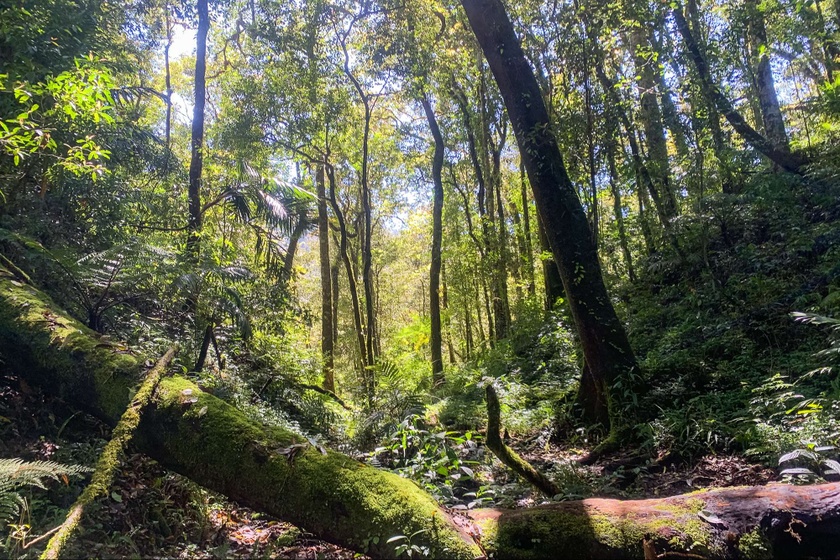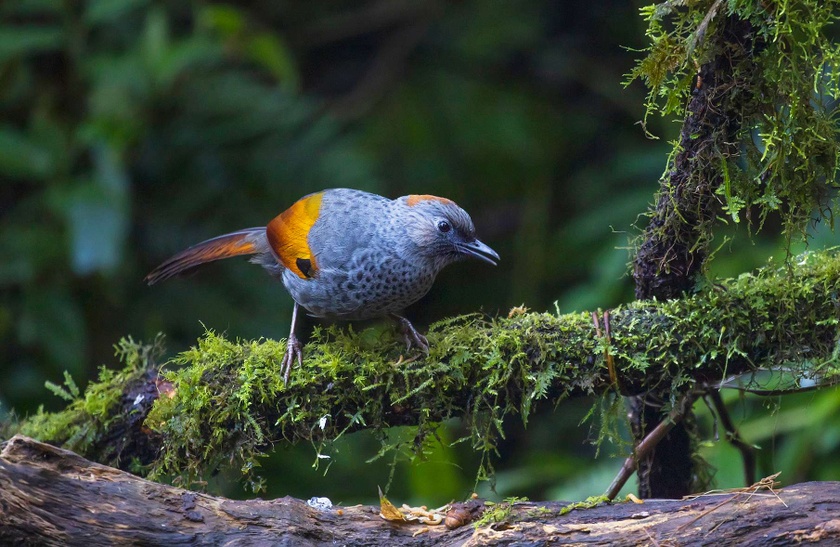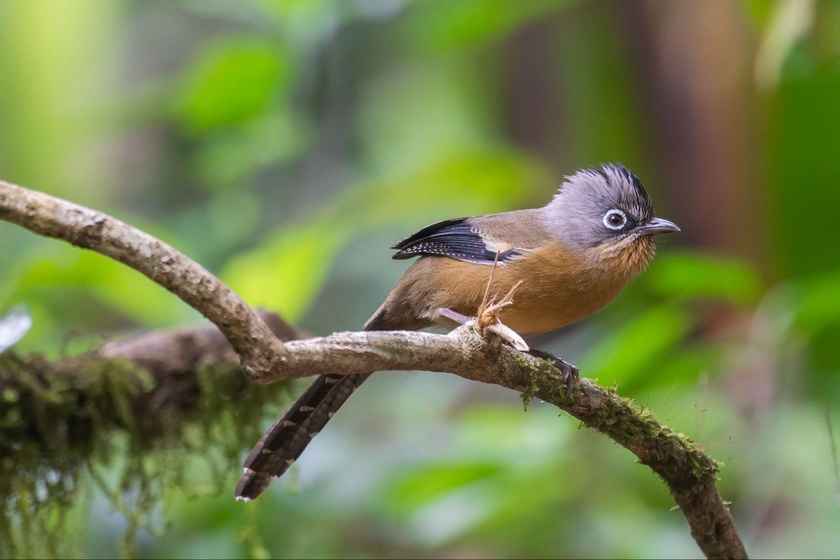Ngoc Linh is a high mountain range that forms the administrative boundary of Kon Tum and Quang Nam provinces with the highest peak at 2,604m and many peaks higher than 2,000m. Ngoc Linh has long been known as the “Roof of the Central Highlands” and the highest in the South. Ngoc Linh Nature Reserve not only has special value in biodiversity conservation, but also has great value in military, national security and tourism.
 |
Under the canopy of Ngoc Linh forest. Photo: NB |
Ngoc Linh Nature Reserve is surrounded by 96.82% of forest area of all kinds with more than 38,100 hectares, located in 5 communes (Dak Man, Dak Choong, Muong Hoong, Ngoc Linh, Xop commune) of Dak Glei district. Ngoc Linh buffer zone includes 8 communes of Dak Glei district, 3 communes of Tu Mo Rong district. Ngoc Linh Nature Reserve together with Song Thanh Nature Reserve and Ngoc Linh Nature Reserve of Quang Nam form the largest continuous nature reserve area in Vietnam with about 150,000 hectares.
Ngoc Linh is not only known as a place with many rare medicinal herbs such as Ngoc Linh ginseng, red ginseng, Panax notoginseng, green lim mushroom, co co lingzhi... but also the capital of many rare and endemic bird species of our country. According to records, Ngoc Linh Nature Reserve has 234 bird species belonging to 11 orders, 43 families. There are 41 rare and protected bird species, of which: Vietnam Red Book has 13 species, including 1 species at EN level (endangered), 8 species at VU level (vulnerable), 4 species at LR level (less endangered); Red Book of the International Union for Conservation of Nature and Natural Resources (IUCN) has 11 species, including 1 species at EN level, 2 species at VU level, 8 species at NT level (vulnerable); The Decree 06/2019/ND-CP lists 38 species, including 7 species in group IB and 31 species in group IIB. In particular, the Ngoc Linh laughingthrush is an endemic species in Vietnam.
 |
Ngoc Linh laughingthrush at Ngoc Linh Nature Reserve. Photo: NB |
Ngoc Linh Babbler has the full scientific name Trochalopteron ngoclinhense, belongs to the passerine order, was discovered and scientifically described in 1999 by conservation experts and wildlife researchers: Jonathan C. Eames (UK), Le Trong Trai and Nguyen Cu.
The distinguishing features of the Ngoc Linh thrush are that the adult bird has a grey-brown forehead with a dark brown colour between the feathers behind the eyes and on both sides of the head. The top of the head and nape are dark reddish brown; the shoulders, back and flanks are greyish-yellowish brown. The upper tail coverts are grey mixed with yellowish-brown. The underside of the tail is dark brown. The large wing coverts are yellowish-brown with a wide dark reddish-brown band; the inner wing corner feathers are black; the primary wing coverts are black. The area before the eyes is black, the ear coverts are grey, the middle and sides of the chest are grey and silvery grey. The belly to the underside of the tail is greyish-yellowish brown. The beak is black-horned; the legs are dark brown; the eyes are dark brown.
The characteristics of this babbler species are that it lives mainly on mountain tops at an altitude of 1,480 - 2,200 m, with a narrow distribution area, often in pairs or small flocks, and is very shy. The habitat is evergreen broadleaf forests on high mountains, with good vegetation cover, and many symbiotic plant species on tree trunks.
According to some ornithologists, currently, the number of adult Ngoc Linh babblers is only 1,000 - 2,400 individuals. The number of individuals in the wild is decreasing rapidly and is difficult to recover due to the main reasons such as: Their habitat is narrowed due to deforestation for farming, clearing vegetation under the forest canopy for medicinal plant cultivation; illegal hunting, buying and selling, and captivity are still happening every day.
Talking with Mr. Bui Thanh Trung (who was honored by Birdlife International for his contributions to bird research in Vietnam), we learned that in recent years, every year he has traveled to the mountainous areas of Kon Tum to record images of bird species and learn about their characteristics and distribution areas.
It must be said that Kon Tum has a very diverse and rich bird fauna, especially with many endemic and sub-endemic species of Vietnam. Notable species include Ngoc Linh laughingthrush, Kon Ka Kinh laughingthrush, black-chinned flat-billed laughingthrush, black-headed striped laughingthrush, green hooked laughingthrush, and red-tailed laughingthrush. However, it is increasingly difficult to encounter Ngoc Linh and Kon Ka Kinh laughingthrush in the wild due to the increasingly narrowing habitat.
Faced with the problem, authorities at all levels need to pay more attention and take drastic measures to protect endemic babbler species in general and wildlife species in particular to preserve and restore the number of individuals in the future. Especially the Ngoc Linh babbler, an endemic species recorded only in the Ngoc Linh mountainous forest area.
 |
Black-headed babbler at Ngoc Linh Nature Reserve. Photo: NB |
The International Union for Conservation of Nature and Natural Resources (IUCN) Red List classifies the Ngoc Linh laughingthrush as Endangered (EN). In Vietnam, the Ngoc Linh laughingthrush is listed in the list of endangered, precious, and rare forest flora and fauna (Group IB) stated in Decree 84/2021/ND-CP amending Decree 06/2019/ND-CP on the management of endangered, precious, and rare forest flora and fauna and the implementation of the Convention on International Trade in Endangered Species of Wild Fauna and Flora.
According to Article 244 of the 2015 Penal Code, amended in 2017, which regulates the crime of violating the protection of endangered, precious, and rare animals, the highest penalty for illegal hunting, killing, raising, confining, storing, transporting, and trading of Ngoc Linh laughingthrushes and species in group IB is 2 billion VND and 15 years in prison. People, especially ethnic minorities in the Ngoc Linh mountainous area, need to know these regulations so as not to violate the law.
According to NGUYEN BAN (baokontum)




























![[Photo] National Assembly Chairman Tran Thanh Man visits Vietnamese Heroic Mother Ta Thi Tran](https://vphoto.vietnam.vn/thumb/1200x675/vietnam/resource/IMAGE/2025/7/20/765c0bd057dd44ad83ab89fe0255b783)









































































Comment (0)